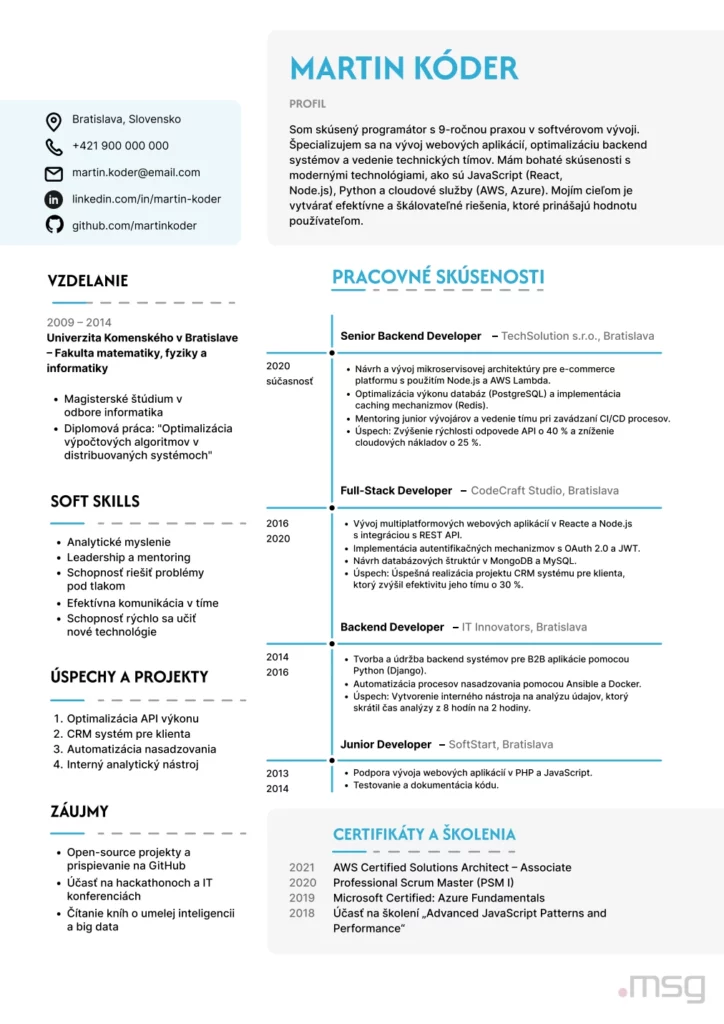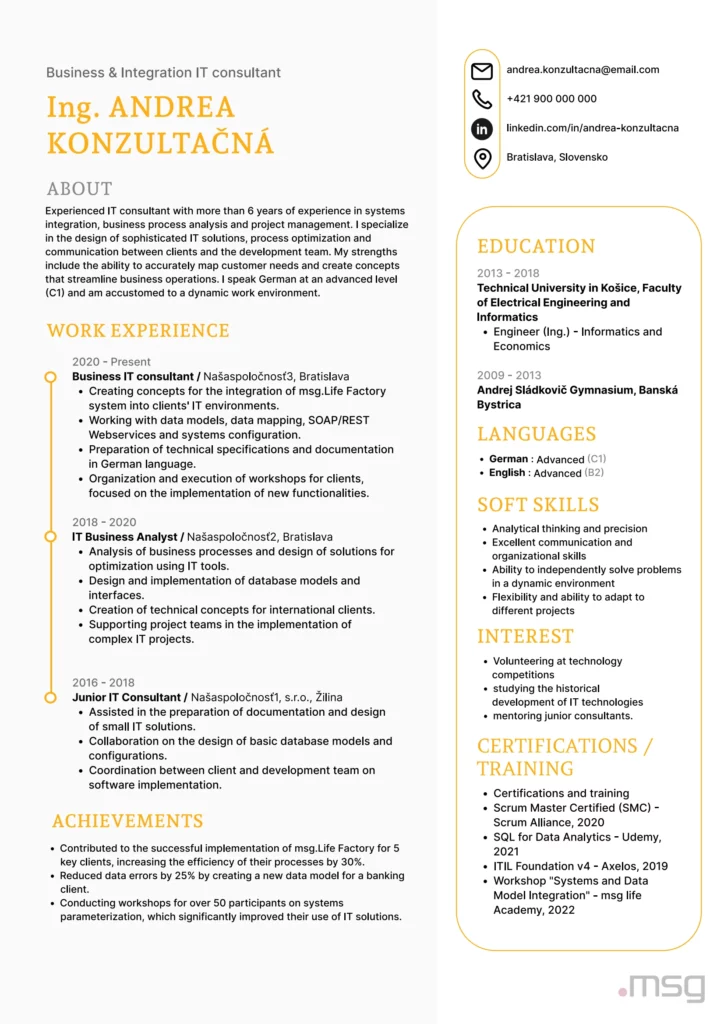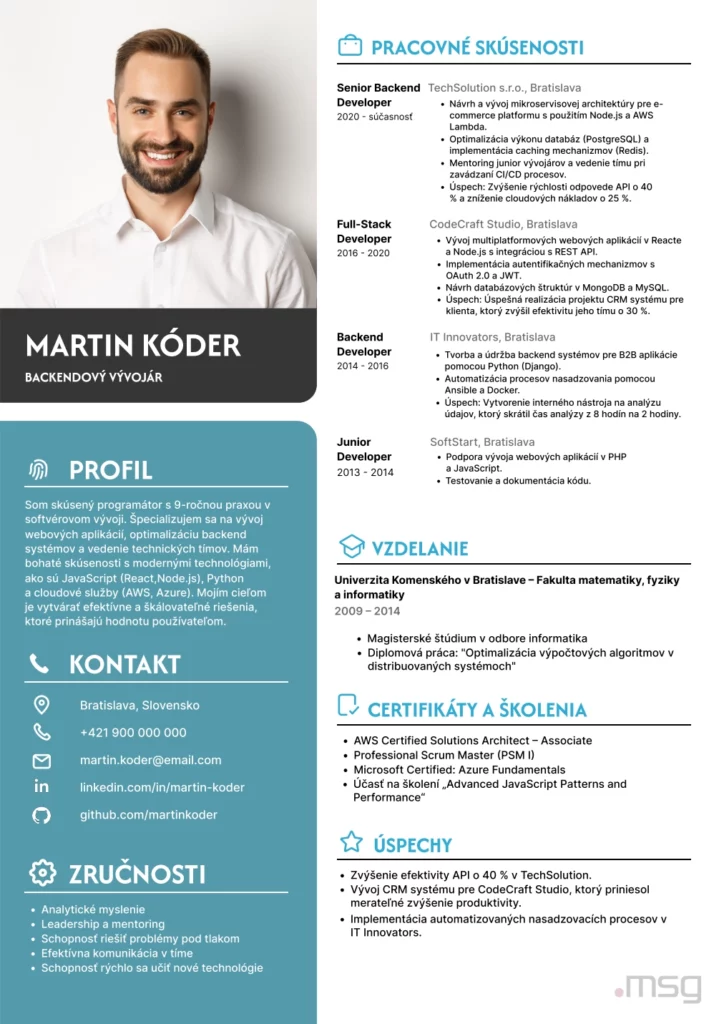CVs – Templates, mistakes, and tips on how to write them correctly
CV templates and pre-prepared templates are excellent tools that allow you to write this document in just a few minutes. However, to truly capture the attention of a future employer and secure your dream job, you must pay attention to several details and nuances. What are they, and what should you consider when writing a CV?

In the article you will learn:
What is a CV?
A CV is one of the documents you will need when you decide to look for a new job. It contains basic information about you, your work experience, skills, education, hobbies, and interests, presenting you to a potential employer. Essentially, it is your “career in a nutshell” – a concise summary of your qualifications for the position you are applying for.
Writing a CV is not difficult, but it is important to pay close attention to grammar, style, formatting, and the information you include. Otherwise, you may fail to make a good first impression and could miss out on your desired job.
How CVs have changed over time
The term “curriculum vitae” is believed by experts to originate from the 15th century, with Leonardo da Vinci credited as its inventor. In 1482, he wrote a letter listing his abilities and sent it to Ludovico il Moro, the then Duke of Milan.
Even during the Renaissance, people recognized the importance of individual success and began presenting it to others. The first CVs were simple and unformatted. Skills, abilities, and work experience were listed in chronological order, and unlike modern CVs, they were not as concise.
Everything changed with the arrival of the 20th century when people began introducing standards and requirements for CVs. The primary reason was to simplify employee recruitment. The same century also saw a shift in CV creation, as handwritten documents were replaced by those typed on typewriters.
The last major change came at the turn of the millennium, with the preference for electronic documents. And although it is now possible to create creative and visually elaborate documents, most employers prefer a simple, structured CV containing essential information.
CV templates: What sections do they include?
Every CV template should include several basic sections to give a future employer a better understanding of you. These sections are:
Personal details
This is the section at the very top of the CV. You should include the following information:
- First and surname
- Address
- Phone number
Always double-check your personal details. This is especially important for your phone number and email, as these are how a potential employer will contact you if interested.
Some people also add a photograph to this section. While not mandatory, a photo can make a CV feel more personal. If you choose to include one, select a professional image. Avoid selfies or informal photos from parties, social events, and similar occasions.
Work experience
In this section, you can elaborate on your work experience. If you have held multiple positions, it is customary to list the last three or four. Others can be mentioned during the job interview, in a cover letter, or in your portfolio, to which you can provide a link for recruiters.
Work experience should be listed in reverse chronological order. This means you start with your most recent job and work backward.
Remember that a CV should be concise and to the point, so avoid writing too much about your work experience. Simply include:
- Job title
- Company name
- Time period in the role
- A brief description of the role in one or two sentences (optional)
Instead of a brief job description, you can list the scope and responsibilities of the role or the experience you gained in bullet points.
Education
As the name of this section suggests, it is intended to present your education. You write it in the same way as your work experience – in reverse chronological order. The first entry should be your university education, followed by your secondary school.
For each school, include the years you attended and the qualification you obtained, such as A-levels, a bachelor’s degree, or a master’s/engineering degree.
You can also incorporate courses or training you have completed into the education section.
Skills
This section allows you to stand out from other candidates and showcase your strengths to recruiters. Highlight what makes you unique and emphasise your strongest attributes. However, be careful not to include irrelevant information. Try to determine which of your skills would be most useful for the specific job position.
You can list, for example:
- Language skills
- Knowledge of computer programs
- Communication skills
- Organizational abilities
- Leadership skills
Do not overdo it with skills. Mention three, or at most four, and provide additional details, such as a situation where you used them, how they helped you, or where you acquired them.
Hobbies and interests
This is an optional section, but it is worth including in your CV. It serves a similar function to a photograph – it personalises the document and helps you stand out from other candidates. Ideally, it should remain concise and not go into too much depth. Simply list some of your hobbies and interests.
What is considered appropriate to mention? Almost anything you enjoy doing, such as sports, volunteering, travelling, or creative activities like photography or painting.
Additional sections
If your CV is not too long, you can add further sections. Suitable additions include references from a previous employer, awards, or certificates. If you do not have any of these, submit your CV as it is – with just the basic information about your education, work experience, and skills.
What is a structured CV?
Nowadays, you can write several types of CVs. The most basic and commonly used is the structured CV. It is characterised by a simple layout and contains only key information, including:
- Personal details
- Work experience
- Education
- Technical and language skills
- Abilities
Additional sections, such as hobbies, may or may not appear in a structured CV
A structured CV is distinguished by its clear and logical structure, containing only relevant information. It is well-organised and has a formal, no-nonsense appearance.

What types of CV structures are there?
When writing a structured CV, in addition to the division between classic and modern CVs, you will encounter three other types:
Chronological CV
This is primarily used to present your work experience. For this reason, the work experience section is placed directly below your personal and contact details. This is followed by your education level, skills, and, if necessary, other optional sections. Since the chronological type focuses mainly on your work history, you can allocate more space to it. However, do not overdo it to ensure the document remains easy to read.

Skilled-based CV
Some sources also refer to this as a functional CV. Its main purpose is to highlight your skills. A list of skills with a brief description is placed directly below your personal details. This is followed by your education level, work experience, and optional sections.

Combination CV (Hybrid CV)
This is useful if you cannot decide between a chronological and functional CV template. It is characterised by emphasising both work experience and skills, giving equal space to both. Its structure is such that, after personal details, skills are listed first, followed by work experience, education level, and optional sections.

How to write a CV
Writing a CV is not difficult. Just follow a few rules:
- Always allocate enough time for writing and do not rush.
- Read the job advertisement carefully to incorporate relevant information into your CV.
- Use CV templates to help with formatting, so you can focus on writing rather than layout adjustments.
- Write in bullet points. Avoid long, complex sentences.
- Have someone else proofread your CV to catch any typos or errors you might miss.
Mistakes in a CV
Errors in a CV come across as very unprofessional and can ruin a first impression. The most common mistakes include grammatical and stylistic errors. Another frequent issue is incorrect formatting (varying font sizes, multiple colours, etc.), excessive length, and irrelevant or false information.
Skills in a CV
Professional experience and education are important, but employers often look for additional skills you can offer. Therefore, do not forget to include them in your CV and always mention what could help you secure the job.
You can also indicate your proficiency level in certain skills. For languages, for example, the scale from A1 to C2 is commonly used.
Formatting a CV
When formatting your CV, follow these rules to ensure it looks professional:
- Use only one font type, one size, and one colour (ideally black).
- If you want to separate sections, you can use bold text or a slightly larger font.
- Avoid using coloured backgrounds, images, or other decorative elements.
- Your CV should be no longer than two to three pages, including references.
- Focus on your achievements – for example, in work or education.
- Save the document in PDF format.
- Ensure consistent line spacing throughout the document.
CV templates for everyone
Today, there are many CV templates available, varying depending on profession and situation – whether you are a student, a programmer, or looking for work abroad. If you fall into one of these categories, you will find templates below to help you with your writing.
Student CV template
A CV template for university applicants, as well as a template for secondary school students, focuses mainly on academic achievements and education. Do not hesitate to write a little more about these.
Programmer CV template
Interested in a programming job? In your CV, be sure to highlight technical skills and work experience. Education and other relevant abilities are also important. For more information, see our article: Programmer CV: How to Write a developer CV + IT CV Templates.
CV template in English
Whether you plan to work abroad or stay in your home country but have a foreign employer, you will likely need a CV in English and possibly German. This differs slightly in structure from a CV in your native language.
Employer references in a CV
You can attach references from a former employer, manager, or other superior to your CV. Remember that they should be concise and clear. They must also include contact details for the person providing the reference so recruiters can verify its authenticity and learn more about you.
Choose a template and write a professional CV
Writing a CV may seem complicated at first glance. However, if you know what mistakes to avoid and what to include, everything becomes much simpler. Moreover, you now have access to various CV templates to help your document look professional.
FAQ
1. What types of CVs exist?
There are three main types of CVs: chronological, functional, and combination. The chronological type focuses on work history, the functional type emphasises skills, and the combination type merges both approaches.
2. What information should a CV include?
A CV should include your personal details (name, contact information), a brief profile or career objective, work experience, completed education, skills, and possibly certificates or awards.
3. What should an ideal CV look?
An ideal CV should be clear, professional, and tailored to the position you are applying for. Use clear headings, bullet points, and a readable font.
4. Can I use CV templates?
Yes, templates are a great way to save time and gain inspiration. Ensure the template is modern and adaptable to your needs.
5. What is the ideal length of a CV?
A CV should typically be one to two pages long, depending on your work experience. Recent graduates may only need one page, while experienced professionals may require two.
6. Is it important to include a photo in a CV?
In some countries and industries, a photo may be beneficial, but in others, it is better to avoid it. Always follow the norms and culture of the field you are applying to.
7. How can I increase my chances of getting an interview with my CV?
Focus on relevant skills and achievements, use keywords from the job advert, and make sure your CV is free from grammatical errors and typos.
8. Can I include references in my CV?
References are usually provided upon request, so it is not necessary to include them directly in the CV. However, you can state that they are available upon request.
9. How often should I update my CV?
It is recommended to update your CV after every significant change, such as a new job, acquiring new skills, or completing education. Keep it up to date so you can respond quickly to job opportunities.
